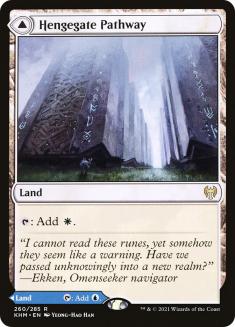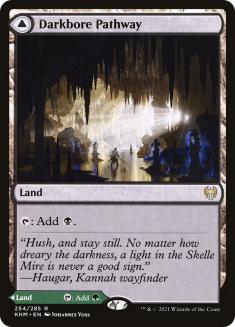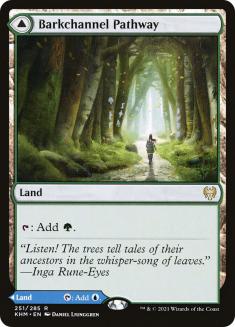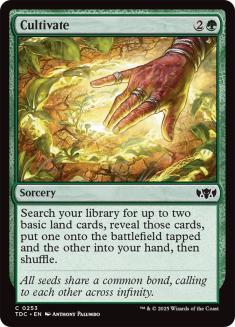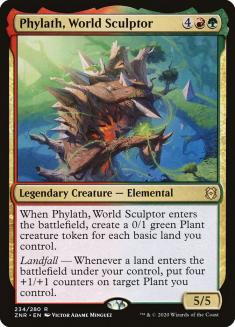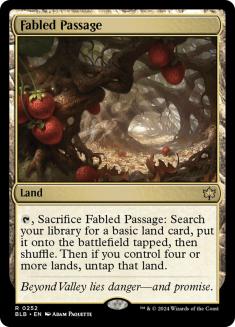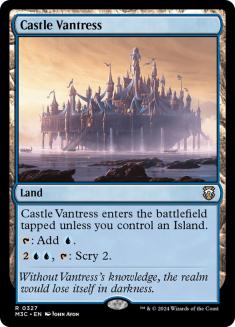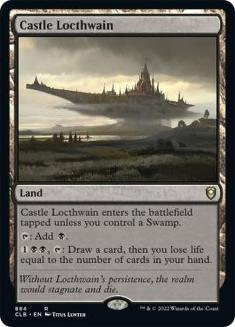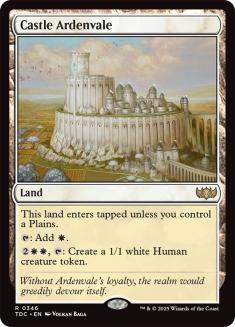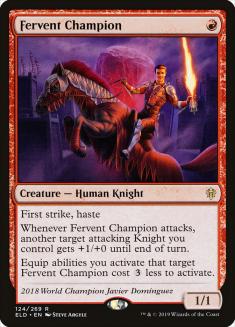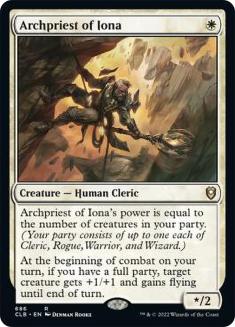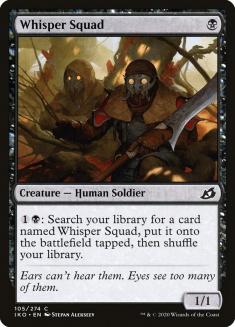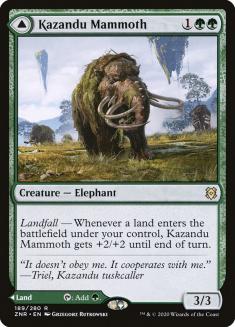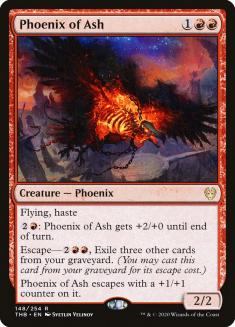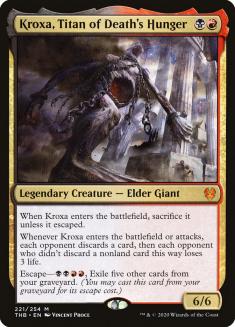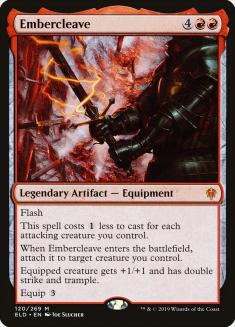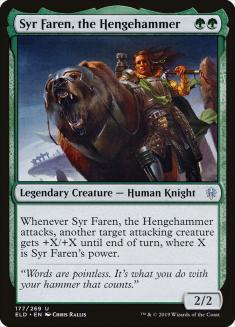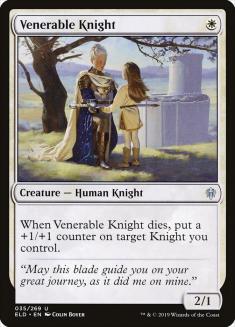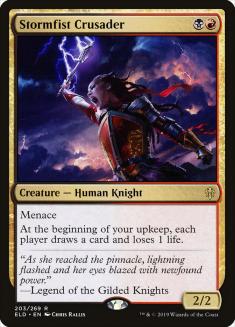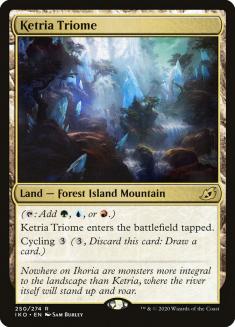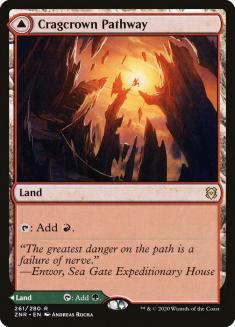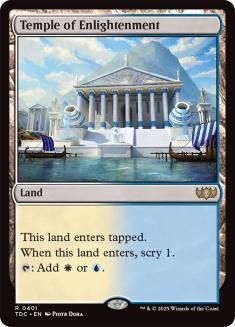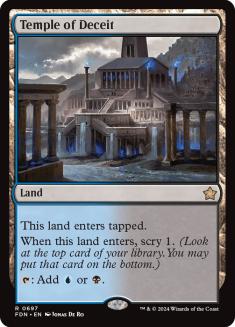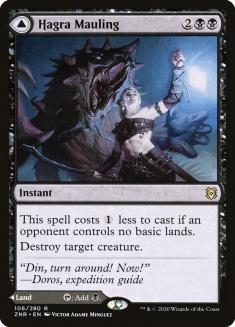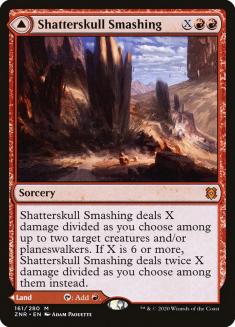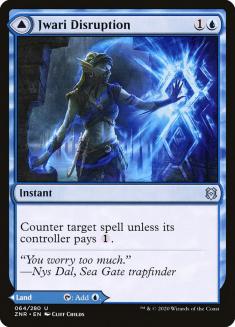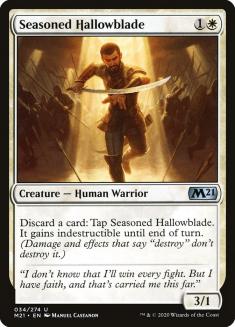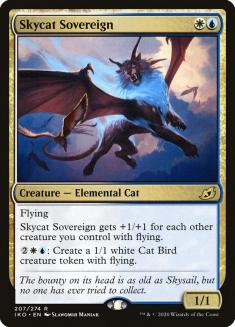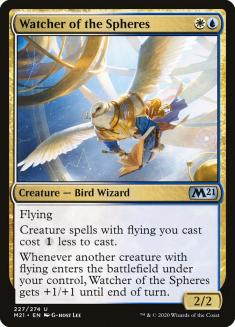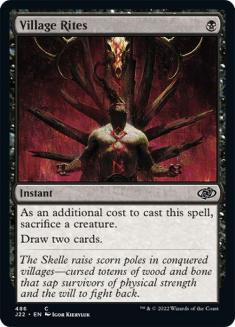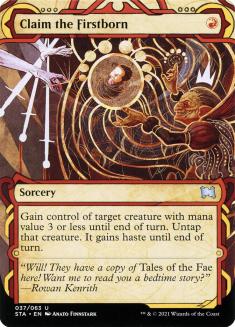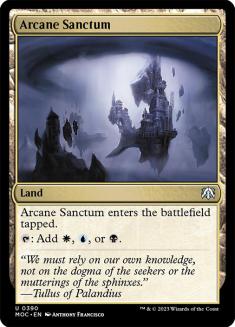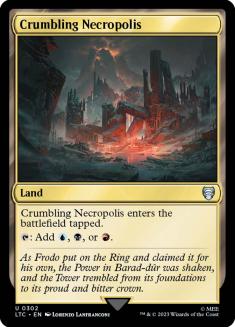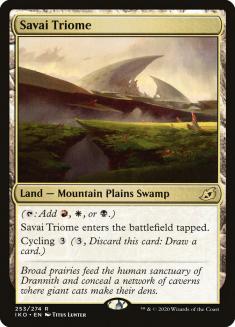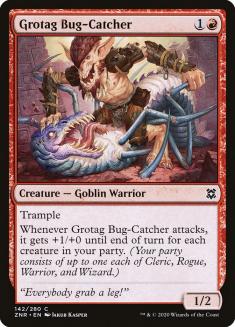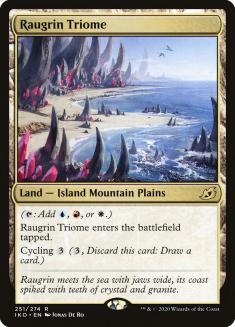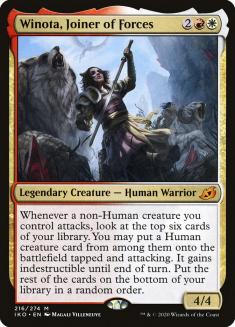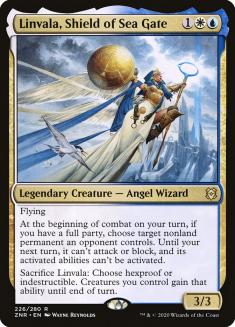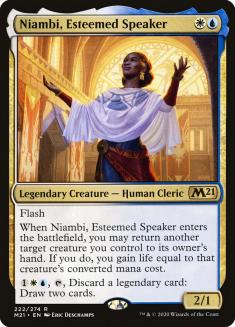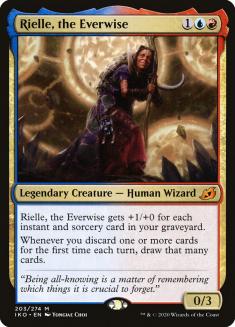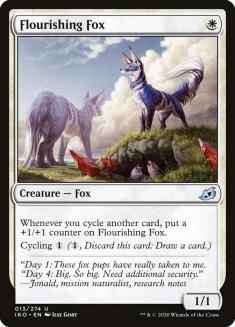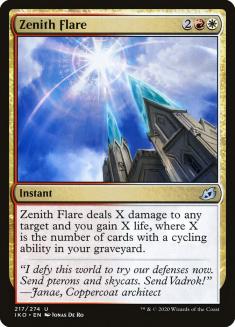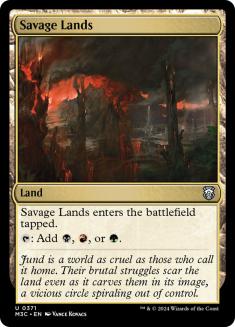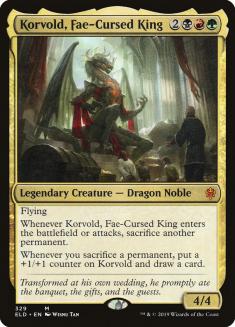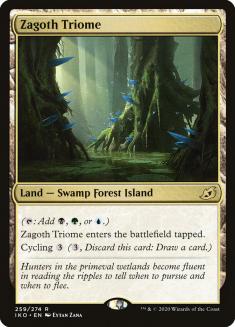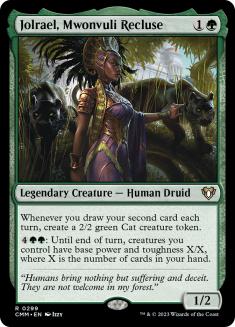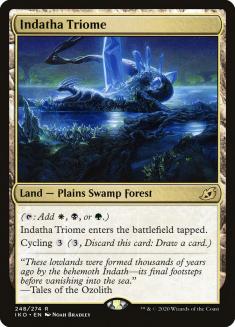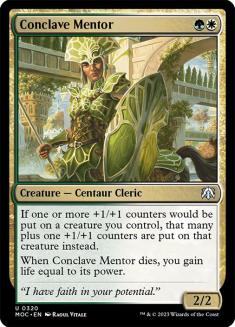I love talking about how mana impacts a format. I really love talking about how new, unexplored lands impact a format.
And when that format is the current Standard, a format so stocked with forgotten things from Throne of Eldraine and Theros Beyond Death that could easily find a broken home if you tied the right pieces together? And the new mana is wrapping up a cycle of always untapped multicolor lands?
Even with so little of the rest of Kaldheim revealed, there’s a lot to talk about how these four Pathways will impact the format.
What Are Pathways Good At?
Adding Pathways to your Standard deck is always going to make your mana better and not worse. The floor of the card is the same as a basic land, and as far as I can tell every Standard deck has some of those to upgrade. There’s minimal nonbasic land hate in the format and the hate that does exist is on mediocre creatures and is low-impact.
The main reason to not play Pathways in Standard is if you have the green cards that specifically ask about basic lands. I expect the Genesis Ultimatum decks to not play a full twelve Pathways because they need basic lands to find with Fertile Footsteps or Cultivate. Phylath, World Sculptor might be the most direct reason to not play Pathways, but so far other finishers have proven to be more powerful than it.
The other reason Pathways have a cost are the Throne of Eldraine Castles. I’m mostly concerned about losing out on the Esper trio of Castles here, with the Gruul pair having less flexible effects anyway. It isn’t too bad if you still have a Triome and Fabled Passage in your deck, or just play two colors, but some of the more ambitious Pathway manabases won’t be remotely close to having untapped Castles.
The things Pathways are best at relative to other multicolor lands is casting one-drops. I won’t get started on my rant about how we deserved better one-drops in Standard all of last year, but that shallow pool of options looks a lot better if you start to stitch the good ones in multiple colors together, or if you just get to cast two colors of spells without losing the chance to cast them on Turn 1.
The thing Pathways are worst at? Double-color costs on cards. Like I said at the start, they are assured to be better than a basic land in these situations, but they are way worse than a Temple or shockland would be. This is part of why you see Gruul Adventures’s curve split the way it is: Lovestruck Beast wants you to commit Cragcrown Pathway as a green source early, Kazandu Mammoth wants double green on Turn 3, and the deck ends up really close to Mono-Green splashing Bonecrusher Giant and Embercleave. Maybe if Stomping Ground were in the format instead the deck would be split a little more evenly, but we have Cragcrown Pathway and the zero Temple of Abandons most lists play.
Once you clear that Turn 3 hurdle, the split double-color cost issue is signficantly reduced and I wouldn’t worry about Pathways messing with your mana. There’s just more time to route away from an early commitment with future Pathways or Fabled Passage. It’s also much more likely your higher-cost card is still fine when delayed by a turn or two, whereas Kazandu Mammoth is way better on Turn 3 than any other time.
Double-color-costed two-drops are scarce in the format, but I would consider them basically monocolored deck exclusives with the lands we have now. Technically your Darkbore Pathway to splash black with Syr Faren, the Hengehammer is completely free, but the Temple of Malady that comes after it isn’t. Four sources isn’t enough to splash anything besides an optional off color activation, and there isn’t a Scrapheap Scrounger in this format to incentivize that.
Well, except Kenrith, the Returned King, but you will put that card in your deck for a reason and then consider the splash activations.
Another weakness of Pathways comes up when you start looking at three-color decks. While it might look like Mardu Knights is free of Savai Triome, the same Pathway decision issue comes up when you try to bridge mixed one-drops with multicolor two-drops. There is no way to use two Pathways to curve Venerable Knight into Stormfist Crusader. If your three-color deck is mixing one-drops with multicolor two-drops, you need everything to line up in one color. You could play Venerable Knight, Inspiring Veteran, and Wintermoor Commander since a Turn 1 Brightclimb Pathway makes the white mana for all of them.
If you aren’t trying to cast early drops, the draw of Pathways is that they combine with Triomes to make full three-color mana nearly free.
A Triome and a full set of Pathways is a minimum of twelve sources of each of your colors, which has traditionally been the floor for a tertiary color. Sultai Food in the Oko, Thief of Crowns era had twelve black sources for Noxious Grasp and some other flex cards; Sultai Midrange in the Ravnica Allegiance-era had twelve sources for Hydroid Krasis and Hostage Taker; and so on.
Add in Fabled Passage with six basic lands, and you have eighteen sources of each color and only four lands that enter-the-battlefield-tapped past Turn 3. That’s absolutely free.
For non-Triome trios, there’s a bit more of a decision. With just Fabled Passage and Pathways you have mostly untapped lands but mana counts in the mid-teens that fall solidly into the “risky aggro mana” realm. You can also play Temples if you’re willing to sacrifice curving out, but the downgrade from Triomes forces you to choose. You can choose two main colors or have borderline mana in all three where you have to actively avoid any double-color-costed cards.
Creatures (36)
- 4 Lotus Cobra
- 4 Lovestruck Beast
- 4 Giant Killer
- 4 Edgewall Innkeeper
- 4 Bonecrusher Giant
- 4 Winota, Joiner of Forces
- 4 Basri's Lieutenant
- 4 Selfless Savior
- 4 Kazandu Mammoth
Lands (22)
Spells (2)

If you want to talk risky aggro mana, look no further than current Naya Winota. Naya was the only trio with a full set of Pathways from Zendikar Rising, and this is what comes out of it. No double-costed cards in any color, bar Kazandu Mammoth which is also a land and The Great Henge at the top of the curve, and relatively even spreads of card colors and land colors.
Pointing directly at the Kazandu Mammoths in the Naya list, some of this constraint can be ignored if you play a ton of modal DFCs. Here’s a lesson in mana math, brought to you from Khans of Tarkir Limited.
I’ve glossed over some numbers in the mid-to-high teens for good source counts for a color. The average deck plays 24 lands, which, if you simply divide 24 by two colors, that clearly wouldn’t work, let alone if you are three colors.
Usually the solution is multicolor lands. Each multicolor land you add is effectively a +1 to your source count, so the typical eight multicolor lands in a two-color deck will stretch that 24 lands to 32 sources, sixteen of each, pretty close to optimal. There’s actual math behind the default two-color manabase.
But if you literally played 32 lands, the math also works! You can always have better colored mana if you play more lands, and the Zendikar Rising modal DFCs let you do that without flooding quite as often. You have some multicolor lands so you don’t literally need 32 lands, but having four modal DFCs on top of 24 lands will really reduce the odds you are color screwed.
Since modal DFCs are largely enter-the-battlefield-tapped lands, they mostly benefit the slower no-Triome trios I was just talking about. If somehow you dropped Cruel Ultimatum into this format, the way to play it would almost surely involve stacking up Jwari Disruption, Shatterskull Smashing, and Hagra Mauling so your “bad mana Grixis” deck just had 30 or more mana sources and made that Ultimatum cost look easy. In the real contents of Standard, if you wanted to Esper it up and play Murderous Rider, Neutralize, and Nine Lives, you’d be in a similar boat.
What Are the New Rewards?
Four color pairs of Pathways open up four color pairs, but basically every color trio gets an upgrade.
Azorius isn’t a color combo known to dislike Temple of Enlightenment, but there is a niche for an Azorius Tempo deck to exist. I have recently bashed a couple of people in Arena Cube with Seasoned Hallowblade plus Staggering Insight and I’m interested in seeing if it has legs in a real format. I want to preserve a lot of what Ross Merriam laid out last week talking about Halvar, God of Battle, but I’m fairly sure protecting Staggering Insight is by far the best thing to be doing with these cards now that the mana supports it.
Creatures (29)
- 4 Giant Killer
- 3 Alseid of Life's Bounty
- 3 Lavabrink Venturer
- 4 Seasoned Hallowblade
- 4 Selfless Savior
- 4 Skyclave Apparition
- 4 Luminarch Aspirant
- 3 Halvar, God of Battle
Lands (20)
Spells (11)
Sideboard

The Tier Fun deck in Azorius that benefits from Hengegate Pathway is Azorius Skies. Skycat Sovereign and Watcher of the Spheres are underrated cards that just happen to get Stomp’ed on.
Creatures (22)
- 4 Rankle, Master of Pranks
- 2 Embereth Shieldbreaker
- 2 Murderous Rider
- 4 Bonecrusher Giant
- 2 Ox of Agonas
- 4 Mire Triton
- 4 Kroxa, Titan of Death's Hunger
Lands (20)
Spells (18)

Rakdos Midrange was already a moderately successful archetype in Zendikar Rising Standard on the strength of escape cards against Dimir Rogues and just in general, since Kroxa, Titan of Death’s Hunger is the legal counterpart to a rightfully banned card.
What Blightstep Pathway opens up is the ability to play one-drops, and from there you can start to consider Rakdos Sacrifice. The payoffs are smaller than we had when Priest of Forgotten Gods was legal, but the Claim the Firstborn targets are much more exciting.
Last week I wrote about Magda, Brazen Outlaw and my expectations for the card have only risen since then, but I think I’m getting closer to solving the “why Rakdos Sacrifice over Jund Sacrifice with Korvold” question I had at the time.
Creatures (22)
- 2 Rankle, Master of Pranks
- 2 Ayara, First of Locthwain
- 2 Woe Strider
- 1 Lampad of Death's Vigil
- 1 Lurrus of the Dream-Den
- 2 Serrated Scorpion
- 4 Whisper Squad
- 2 Archfiend's Vessel
- 3 Acquisitions Expert
- 3 Skyclave Shade
Lands (22)
Spells (16)

There’s a lot of one-of uncertainty here, but the premise is just layering low-investment creatures and drain effects to make every exchange bad for your opponent with cards like Acquisitions Agent. Blightstep Pathway lets you support the black one-drops and Ayara, First of Locthwain while still playing the couple of red cards you really want, and the lower curve makes slotting in Temple of Malice along the way easier. The heavy black focus also ensures you can cast Agadeem’s Awakening, and this deck absolutely maximizes that card.
You don’t see Slaughter-Priest of Mogis or Magda in this deck because your red mana is positioned to support ending up with a source eventually, not on Turn 2. You also don’t see them because nothing else in your deck really cares if it dies to Stomp, so why play things that would care?
With the new green Pathways I struggle to find reasons to not just add the third color, so let’s jump right into that part of the discussion.
I don’t think much changes for Temur, Grixis, and Esper. These are all color pairs with two Pathways already, so that’s not unexpected, and notably all of these are blue trios.
Temur already existed due to all the green mana fixing, and it is largely up to Kaldheim spells to change how these colors fit together and not the lands.
Grixis is a Temple-favoring color trio, and even if you think about splashing off Pathways, the natural conclusion is splashing blue in Rakdos which was already supported by the Zendikar Rising Pathways.
Esper is in a similar control-heavy, Temple-friendly boat, but it does have the best support for an underutilized Throne of Eldraine all-star: All That Glitters. Here is a rough draft of what I would expect an All That Glitters deck to look like.
Creatures (19)
- 3 Aphemia, the Cacophony
- 4 Alseid of Life's Bounty
- 4 Hateful Eidolon
- 4 Seasoned Hallowblade
- 2 Selfless Savior
- 2 Luminarch Aspirant
Lands (24)
Spells (17)

My initial thought looking at Mardu was getting Woe Strider and Winota, Joiner of Forces back together since Winota lost so many single-card, double-trigger options in rotation, but the rest of the black creatures are really unimpressive.
Instead, I think Mardu might be the right home for the party mechanic. The two-cost Rakdos party payoffs are really well-typed and well-positioned to be aggressive, but white has the good one-drop.
Creatures (32)
- 4 Robber of the Rich
- 2 Drannith Magistrate
- 2 Speaker of the Heavens
- 4 Acquisitions Expert
- 4 Grotag Bug-Catcher
- 4 Archpriest of Iona
- 4 Malakir Blood-Priest
- 4 Luminarch Aspirant
- 4 Fireblade Charger
Lands (22)
Spells (6)

The fact that Archpriest of Iona is still the only good one-drop is a massive issue that leaves this list still in the “look but don’t touch” category, but I’m fairly certain these are the payoffs you want to stitch together. You’re specifically looking for a good one-drop Rogue or Wizard, and from there I think a lot of this deck builds itself. Maybe you want Showdown of the Skalds or Squad Commander over Lurrus of the Dream-Den but those are decisions that only matter once the low-end base is there.
The Winota deck that actually interests me is Jeskai, and funnily enough it’s for a party card in a non-party shell. Linvala, Shield of Sea Gate is just the card for a deck that wants non-Humans and ways to beat interaction.
Creatures (35)
- 1 Giant Killer
- 2 Kenrith, the Returned King
- 3 Rimrock Knight
- 4 Winota, Joiner of Forces
- 4 Basri's Lieutenant
- 4 Selfless Savior
- 2 Niambi, Esteemed Speaker
- 1 Barrin, Tolarian Archmage
- 4 Staunch Shieldmate
- 3 Linvala, Shield of Sea Gate
- 3 Skyclave Apparition
- 4 Magda, Brazen Outlaw
Lands (24)
Spells (1)
Sideboard

Just wanted to highlight that with Giant Killer and Skyclave Apparition to recur and Magda as both extra mana and a potential overkill legend to draw, Niambi, Esteemed Speaker is doing a lot of work here.
I’m also pretty certain Staunch Shieldmate into Magda is going to break opponents’ spirits if not the format over the next months. Six mana on Turn 3 is just not reasonable.
But in the interest of talking about anything but Winota, let’s remind you of another card from the same cycle: Rielle, the Everwise. Zach Allen has promoted this splash into the typical Boros Cycling deck a few times this year and it is near-impossible to hit the brick-and-fizzle spots that sometimes happen with cycling if you control a Rielle. Kazuul’s Fury is also a great way to add to the finishing power of Zenith Flare, and Rielle lets that card shine in spots that aren’t win more on top of Turn 1 Flourishing Fox.
Creatures (16)
Lands (19)
Spells (25)

My default assumption for Jund decks is they will utilize the broken Jund card: Korvold, Fae-Cursed King. In case you missed my article last week, my presumed starting point is the Jund Food deck from there featuring Magda, Brazen Outlaw. Jund is also our first trio to have gained two Pathways this set, which is going to be a huge step forward for those colors.
Creatures (22)
- 4 Gilded Goose
- 2 Rankle, Master of Pranks
- 3 Korvold, Fae-Cursed King
- 2 Murderous Rider
- 1 Wicked Wolf
- 2 Bonecrusher Giant
- 3 Mire Triton
- 3 Kroxa, Titan of Death's Hunger
- 2 Magda, Brazen Outlaw
Lands (24)
Spells (14)
Sideboard

Weirdly, the trio I’ve struggled with the most is among those that gained the most. Sultai got two Pathways, it has a Triome, and I have no idea what to do with it. Similar to Temur, you could have played these colors before but people just weren’t. Just like Temur, I’m filing Sultai under the “wait and see what the spells do” category.
If I had to guess an existing card that gained the most in Sultai from the green Pathways, it’s Jolrael, Mwonvuli Recluse. It’s still a hard sell in a format where Bonecrusher Giant is a top card, but even as a sideboard option, Jolrael seems powerful. You’re already going to play Cling to Dust and Mazemind Tome, so it’s not like you are just adding do-nothing Opts to your deck to support Jolrael.
When I started looking at Abzan, I looked at +1/+1 counters since Golgari was the +1/+1 counter deck in Zendikar Rising Limited. The problem is that deck was terrible in that format, and that extended to any support at higher rarities for Constructed. Grakmaw, Skyclave Ravager just isn’t a good card.
If anything, you’re looking at adding black mana to the aggressive Selesnya shell for Polukranos, Unchained; Nissa of Shadowed Boughs; and maybe some removal. Basri’s Lieutenant is a shockingly bad high-end when it isn’t free and attacking, and some big 2020 hitter like Polukranos would be a welcome way to add power to the deck. I would also give The First Iroan Games, another highlight of Arena Cube, a second chance in this deck.
In the end, I think the real addition for the last two trios, Abzan and Bant, is more flexibility in building a Yorion deck. Selesnya Blink now has to decide which additional basically free colors it wants to try out.
My honest suggestion: Why not both? 80 card decks are more of an “or” kind of situation.
Creatures (20)
- 4 Gilded Goose
- 4 Wicked Wolf
- 1 Charming Prince
- 3 Yorion, Sky Nomad
- 1 Llanowar Visionary
- 4 Skyclave Apparition
- 3 Glasspool Mimic
Planeswalkers (1)
Lands (34)
Spells (25)

And with that, I may have finally gone too far. There literally is such a thing as too many Pathways.
We are entering a Standard where the mana is going to be really good, and that means a lot of options will open up to play with. Four Kaldheim Pathways mean that you aren’t just getting another 300 new cards, but giving 1,000 old cards a completely new context to be viewed in. Just like when the last five shocklands dropped in Ravnica Allegiance and the resulting format was a huge shift from the previous format, Kaldheim will likely be a significant change from the already dynamic Zendikar Rising Standard format.



